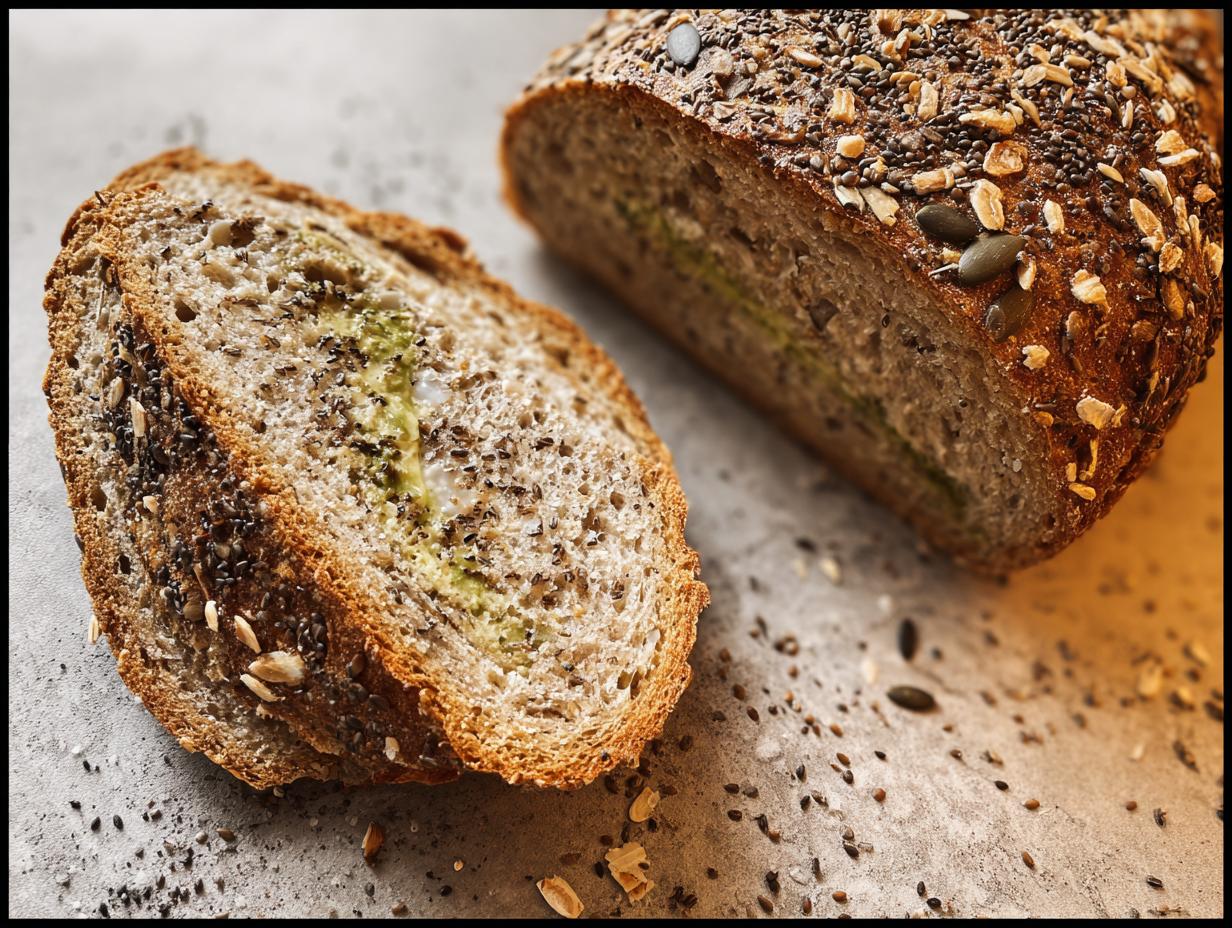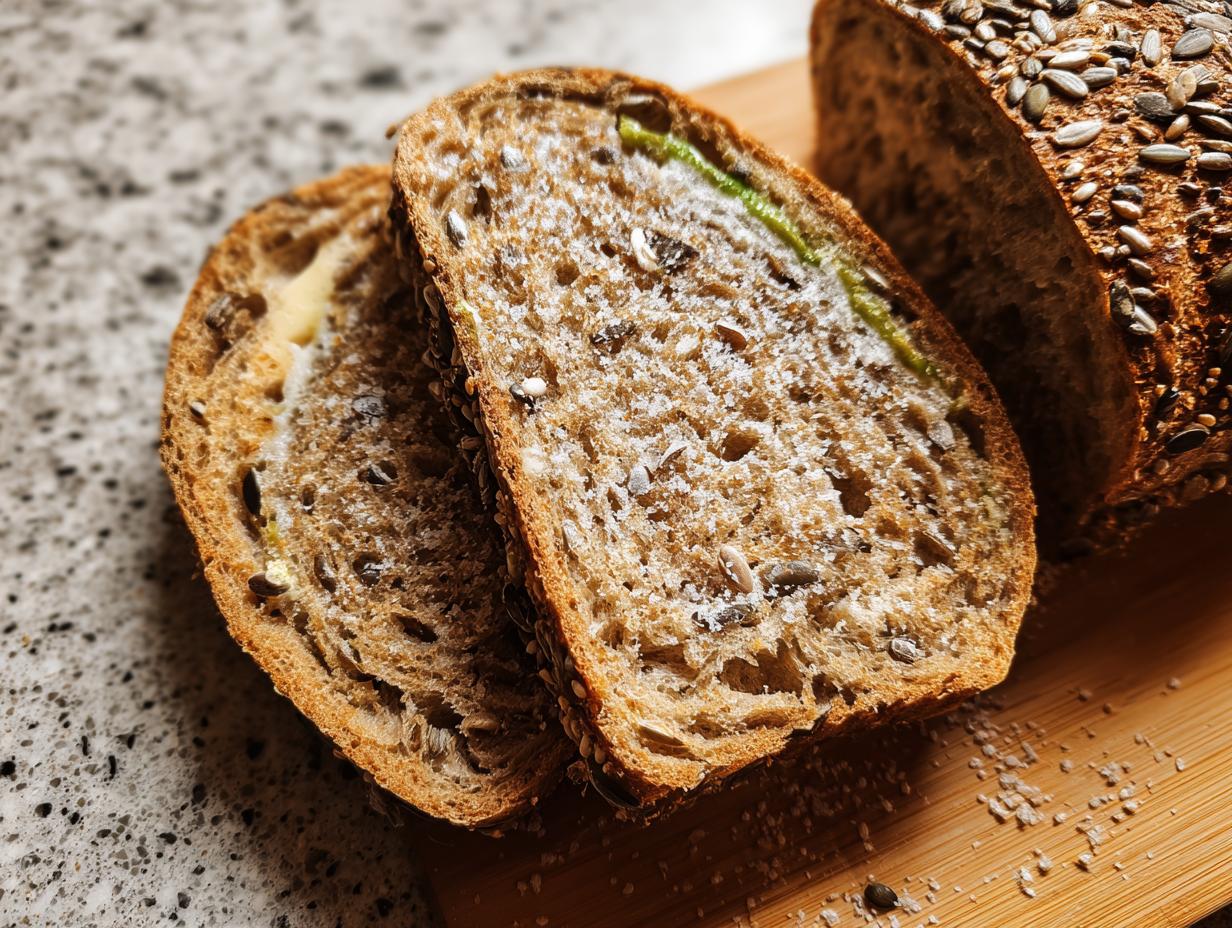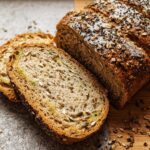Multigrain bread has been a staple in my kitchen for years, and for good reason. It’s more than just a tasty base for my morning avocado toast; it’s a truly healthy grain bread that makes me feel good about what I’m eating. I remember the first time I baked my own, the aroma filling my kitchen was incredible – a mix of earthy grains and a hint of sweetness. It made me wonder, what is multigrain bread made of that gives it such a satisfying flavor and texture? This journey into understanding and enjoying multigrain bread has been so rewarding. Let’s get baking!
What is Multigrain Bread?
So, what exactly makes a bread “multigrain”? Simply put, it means the loaf contains several different types of grains. However, this doesn’t automatically mean it’s a whole grain bread. The key difference lies in how the grains are processed. Many multigrain loaves use refined grains, which have had the bran and germ removed, stripping away much of the fiber and nutrients. True whole grain bread, on the other hand, uses the entire grain kernel. When you’re shopping, always check the ingredient list to see if whole grains like whole wheat, oats, barley, or rye are listed first. This helps ensure you’re getting a truly nutritious mixed grain bread, rather than just a bread with multiple grain types that might be mostly refined.
Benefits of Eating Multigrain Bread
I love that incorporating multigrain bread into my diet offers so many advantages. It’s a simple change that truly makes a difference in how I feel day-to-day. If you’ve been wondering, is multigrain bread good for you? The answer is a resounding yes, especially when you choose wisely!
- Improved digestion: The fiber in multigrain bread promotes a healthy gut and regular digestion.
- Sustained energy: Complex carbohydrates release energy slowly, keeping you fueled for longer.
- Heart health: Regularly eating fiber-rich breads can contribute to lower cholesterol levels.
- Rich nutrient intake: You get essential vitamins and minerals from the variety of grains.
- Weight management support: The fiber helps you feel fuller, potentially aiding in portion control.
- Lower glycemic impact: Compared to white bread, it often causes a slower rise in blood sugar.
How to Make Homemade Multigrain Bread
Making your own multigrain bread at home is incredibly rewarding, and honestly, it’s not as intimidating as you might think! This recipe is perfect for anyone looking for an easy multigrain bread baking experience. The aroma that fills your kitchen as it bakes is just divine, a truly comforting scent. Let’s gather your multigrain bread ingredients list and get started on this delicious, hearty loaf.
- Step 1: First, preheat your oven to 375°F (190°C). Lightly grease a standard 9×5 inch loaf pan.
- Step 2: In a large mixing bowl, combine 3 cups whole wheat flour, 1 cup mixed grain flour blend (or use more whole wheat), 1/2 cup rolled oats, 1/4 cup flax seeds, and 1 tablespoon vital wheat gluten. Whisk these dry ingredients together.
- Step 3: In a separate bowl, warm 1 1/2 cups water to about 110°F (43°C) – it should feel like a warm bath. Dissolve 2 1/4 teaspoons active dry yeast and a pinch of sugar in the water. Let it sit for about 5-10 minutes until it gets foamy. This tells you the yeast is alive and ready!
- Step 4: Pour the foamy yeast mixture into the dry ingredients. Add 2 tablespoons olive oil or melted butter, 1 tablespoon honey or molasses, and 1 1/2 teaspoons salt.
- Step 5: Mix everything with a wooden spoon or your hands until a shaggy dough forms. Turn the dough out onto a lightly floured surface.
- Step 6: Knead the dough for about 8-10 minutes. You’re looking for a smooth, elastic dough that springs back when you gently poke it. It should feel wonderfully soft and pliable.
- Step 7: Place the kneaded dough into a lightly oiled bowl, turning it once to coat. Cover the bowl with plastic wrap or a damp kitchen towel. Let it rise in a warm place for about 1 to 1.5 hours, or until doubled in size.
- Step 8: Once doubled, punch down the dough gently. Shape it into a loaf and place it in your prepared loaf pan. Cover loosely and let it rise again for about 30-45 minutes, until it’s nicely puffed up and almost filling the pan.
- Step 9: Bake in the preheated oven for 30-40 minutes. The crust should be a beautiful golden brown, and the internal temperature should reach around 200°F (93°C). If it sounds hollow when tapped on the bottom, it’s ready!
- Step 10: Let the bread cool in the pan for a few minutes before transferring it to a wire rack to cool completely. This step is crucial for the perfect texture. Enjoy your amazing homemade hearty grain bread!

Pro Tips for the Best Multigrain Bread
Making a fantastic loaf of multigrain bread is all about a few key techniques. I’ve learned that paying attention to the details really elevates the final product, making it truly special.
- Always use a mix of flours for the best texture and flavor; relying solely on whole wheat can sometimes lead to a denser crumb.
- Don’t rush the rising process. Let your dough rise in a warm, draft-free spot until it’s visibly doubled in size.
- Ensure your oven is fully preheated before baking. An accurate temperature is crucial for proper oven spring and crust development.
- Allow the bread to cool completely on a wire rack before slicing. This allows the internal structure to set, preventing a gummy texture.
What’s the secret to perfect artisan multigrain bread?
For that perfect artisan multigrain bread crust and crumb, try using a bit of steam in your oven during the first 15-20 minutes of baking. A Dutch oven or a steam pan filled with water can achieve this, creating a beautiful, crisp crust and a lighter interior. For more baking tips, check out these baking recipes.
Can I make sourdough multigrain bread ahead of time?
Yes! You can prepare your sourdough starter and even mix and ferment your dough for sourdough multigrain bread the day before baking. Store the dough in the refrigerator overnight, then shape and bake it the next day. This method often deepens the flavor. If you’re interested in other bread types, you might like this chocolate bread recipe.
How do I avoid common mistakes with hearty grain bread?
To avoid a dense, heavy crumb in your hearty grain bread, make sure your yeast is active and that you’ve properly kneaded the dough to develop gluten. Also, be patient with the proofing stages; under-proofing is a common culprit for dense loaves. For more baking inspiration, explore this zucchini bread recipe.
Best Ways to Serve Multigrain Bread
I love my multigrain bread toasted with a smear of butter or avocado, but it’s so versatile! Because it’s such a fiber rich bread, it pairs wonderfully with hearty meals. Think of it as the perfect companion to a warm bowl of lentil soup or a hearty chili. It also makes fantastic sandwiches; the sturdy texture holds up well to wet fillings like tuna salad or roasted vegetables. Don’t underestimate it as a side for breakfast, either – a slice toasted with a drizzle of honey or jam is a simple yet satisfying start to the day. For a different kind of hearty meal, try this sausage potato chowder.
Nutrition Facts for Multigrain Bread
When I’m choosing a loaf, I always check the nutrition label to make sure I’m getting the most out of my bread. This nutritious multigrain loaf offers a great nutritional profile compared to many other options.
- Calories: 95
- Fat: 2g
- Saturated Fat: 0.5g
- Protein: 4g
- Carbohydrates: 18g
- Fiber: 3g
- Sugar: 2g
- Sodium: 150mg
Nutritional values are estimates and may vary based on specific ingredients used in your multigrain bread recipe or purchased loaf.
How to Store and Reheat Multigrain Bread
Keeping your homemade multigrain bread fresh is key to enjoying its wonderful texture and flavor. Once your beautiful, nutritious multigrain loaf has cooled completely on a wire rack – and trust me, this is important for the texture to set – you’ll want to store it properly. For everyday enjoyment, a bread box or a clean, dry plastic bag works well for keeping it fresh for about 3 to 4 days at room temperature. If you won’t get through the whole loaf that quickly, freezing is your best bet. Wrap it tightly in plastic wrap, then a layer of foil, and it will keep in the freezer for up to 3 months. When you’re ready to enjoy a slice, you can thaw it overnight in the refrigerator or toast it directly from frozen. For a whole loaf from the freezer, let it thaw at room temperature for a few hours before slicing.

Frequently Asked Questions About Multigrain Bread
Is multigrain bread healthier than white bread?
Generally, yes! The main reason is that multigrain bread, especially when made with whole grains, contains more fiber, vitamins, and minerals than white bread. White bread is typically made from refined flour, which has had the bran and germ removed, leaving mostly the starchy endosperm. This means white bread offers less nutritional value and can cause a quicker spike in blood sugar compared to a good multigrain option. For more on healthy eating, you can explore healthy chicken recipes.
What is the best store bought multigrain bread?
Finding the best store bought multigrain bread involves a bit of label reading. Look for loaves where “whole grain” or a specific whole grain like “whole wheat flour” is listed as the first ingredient. Also, check for the Whole Grain Stamp, which indicates at least 8g of whole grain per serving. Avoid loaves with excessive added sugars or a long list of refined ingredients. Brands that focus on simple, whole ingredients are usually a good bet for a nutritious loaf.
Can I freeze homemade multigrain bread?
Absolutely! Freezing is a fantastic way to preserve the freshness of your homemade hearty grain bread. Once the loaf has cooled completely, wrap it tightly in plastic wrap, followed by a layer of aluminum foil or place it in a freezer-safe bag. This helps prevent freezer burn. It can stay frozen for up to 3 months. When you’re ready to enjoy it, you can thaw slices overnight in the refrigerator or toast them directly from frozen for a quick treat. For another great make-ahead option, consider this banana pudding cheesecake.
What does “seven grain bread” mean?
A seven grain bread is a type of multigrain bread that specifically features seven different types of grains. These can vary widely, but commonly include whole wheat, oats, rye, barley, corn, millet, and sometimes even flax or quinoa. Like other multigrain breads, the nutritional value depends on whether these grains are whole or refined, so checking the ingredient list is always a good idea. You can learn more about different types of grains and their benefits from resources like The Whole Grains Council.
Variations of Multigrain Bread You Can Try
Once you’ve mastered the basic homemade loaf, there are so many exciting ways to customize your multigrain bread! I love experimenting with different grain combinations to create unique flavors and textures. For instance, a seeded loaf packed with sunflower, flax, and sesame seeds adds a delightful crunch and extra nutrients. If you’re looking for something with a deeper, earthier flavor, incorporating a higher percentage of rye flour can transform your bread into a delicious rye-multigrain hybrid. You might also enjoy an oat-heavy version, which yields a wonderfully soft and slightly sweet crumb.
For those who appreciate variety, exploring a seven grain bread recipe can be a fun challenge, offering a complex depth of flavor. And if you prioritize organic ingredients, seeking out an organic multigrain bread recipe or sourcing organic flours and seeds for your own baking ensures you’re getting the purest ingredients possible. Each variation offers a slightly different experience, keeping your bread-baking adventures fresh and exciting! For a sweet baking adventure, try these gingerbread cheesecake cookies.
Print
Multigrain Bread: Amazing 1 Loaf Recipe
- Total Time: 45-55 minutes
- Yield: 1 loaf
- Diet: Vegetarian
Description
Learn what makes multigrain bread truly healthy, how it compares to other bread types, and how to select nutritious loaves. Discover how to identify high-quality multigrain bread and incorporate it into your diet for better health.
Ingredients
- Whole grains (e.g., whole wheat flour, oats, barley, rye)
- Water
- Yeast
- Salt
- Optional: Seeds (e.g., flax, sunflower, sesame), sweeteners (e.g., honey, molasses), fats (e.g., oil, butter)
Instructions
- Read bread labels carefully to understand the types of grains used.
- Prioritize breads that list whole grains as the first ingredient.
- Look for breads with a good source of fiber.
- Check for minimal added sugars.
- Identify breads with the Whole Grain Stamp.
- Compare multigrain bread to white bread and whole grain bread.
- Understand how to assess the healthfulness of your chosen multigrain bread.
- Consider how multigrain bread fits into weight management strategies.
- Evaluate if multigrain bread is suitable for individuals with diabetes.
Notes
- The term “multigrain” only indicates the presence of multiple grains, not necessarily that they are whole grains.
- Refined grains in multigrain bread offer fewer nutrients than whole grains.
- Always check the ingredient list and nutrition facts.
- Look for the Whole Grain Stamp for assurance of whole grain content.
- Prep Time: 15 minutes
- Cook Time: 30-40 minutes
- Category: Baking
- Method: Baking
- Cuisine: International
Nutrition
- Serving Size: 1 slice
- Calories: 80-120
- Sugar: 1-3g
- Sodium: 100-200mg
- Fat: 1-3g
- Saturated Fat: 0-1g
- Unsaturated Fat: 1-2g
- Trans Fat: 0g
- Carbohydrates: 15-25g
- Fiber: 2-4g
- Protein: 3-5g
- Cholesterol: 0mg

